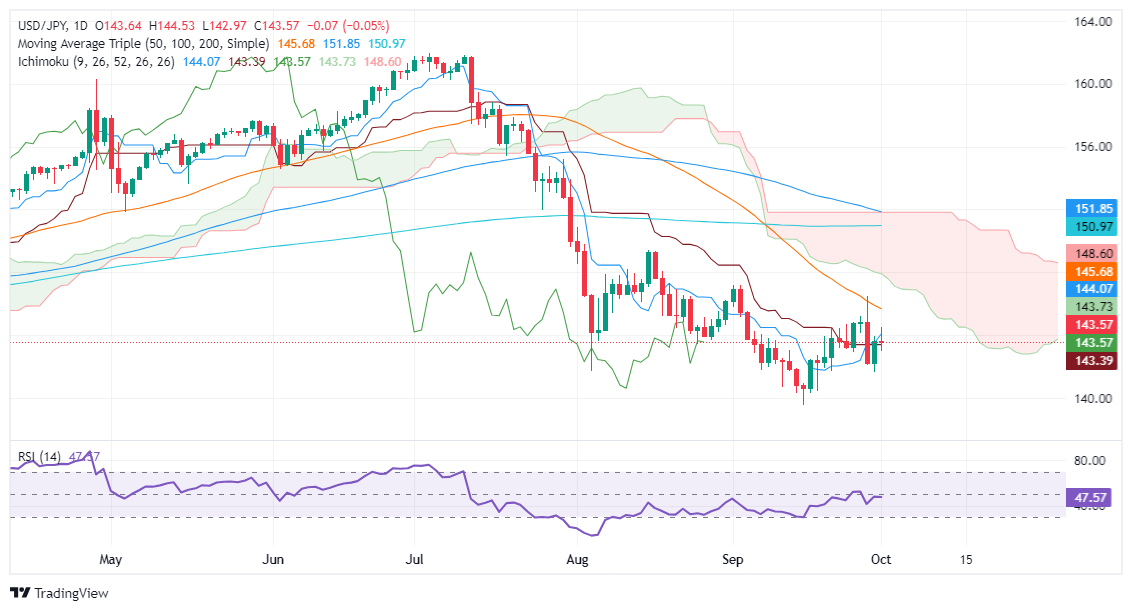- USD/JPY closes unchanged at 143.58, forming a ‘doji’ candlestick, signaling indecision amid geopolitical risks.
- RSI suggests potential consolidation, with the pair expected to trade between 142.98 and 144.53 in the short term.
- A break above 144.53 could target 145.00 and the 50-DMA at 145.47, while a drop below 142.98 exposes the 141.65 support level.
On Tuesday, the USD/JPY formed a ‘doji’ and finished the day unchanged at around 143.58. During the session, the major seesawed at around a 150-pip range before ending the trading day with minimal gains of 0.02%.
USD/JPY Price Forecast: Technical outlook
The downtrend remains intact. Even though the pair was headed to sustain losses, the USD/JPY rallied on risk aversion amidst Iran's attack on Israel. That sponsored a leg-up toward the current exchange rate.
The Relative Strength Index (RSI) favors further downside, though its slope is flat. This hints at consolidation ahead. That said, the USD/JPY might trade within the 142.98-144.53 area in the near term.
If buyers clear the top of the range, that will expose the 145.00, followed by the 50-day moving average (DMA) at 145.47. A breach of the latter will expose the bottom of the Kumo at around 147.80-148.00.
Conversely, if USD/JPY tumbles below 142.98, the September 30 cycle low at 141.65 will be exposed. On further weakness, the next stop would be the September 16 pivot low at 139.58.
USD/JPY Price Action – Daily Chart
Japanese Yen FAQs
The Japanese Yen (JPY) is one of the world’s most traded currencies. Its value is broadly determined by the performance of the Japanese economy, but more specifically by the Bank of Japan’s policy, the differential between Japanese and US bond yields, or risk sentiment among traders, among other factors.
One of the Bank of Japan’s mandates is currency control, so its moves are key for the Yen. The BoJ has directly intervened in currency markets sometimes, generally to lower the value of the Yen, although it refrains from doing it often due to political concerns of its main trading partners. The BoJ ultra-loose monetary policy between 2013 and 2024 caused the Yen to depreciate against its main currency peers due to an increasing policy divergence between the Bank of Japan and other main central banks. More recently, the gradually unwinding of this ultra-loose policy has given some support to the Yen.
Over the last decade, the BoJ’s stance of sticking to ultra-loose monetary policy has led to a widening policy divergence with other central banks, particularly with the US Federal Reserve. This supported a widening of the differential between the 10-year US and Japanese bonds, which favored the US Dollar against the Japanese Yen. The BoJ decision in 2024 to gradually abandon the ultra-loose policy, coupled with interest-rate cuts in other major central banks, is narrowing this differential.
The Japanese Yen is often seen as a safe-haven investment. This means that in times of market stress, investors are more likely to put their money in the Japanese currency due to its supposed reliability and stability. Turbulent times are likely to strengthen the Yen’s value against other currencies seen as more risky to invest in.
Information on these pages contains forward-looking statements that involve risks and uncertainties. Markets and instruments profiled on this page are for informational purposes only and should not in any way come across as a recommendation to buy or sell in these assets. You should do your own thorough research before making any investment decisions. FXStreet does not in any way guarantee that this information is free from mistakes, errors, or material misstatements. It also does not guarantee that this information is of a timely nature. Investing in Open Markets involves a great deal of risk, including the loss of all or a portion of your investment, as well as emotional distress. All risks, losses and costs associated with investing, including total loss of principal, are your responsibility. The views and opinions expressed in this article are those of the authors and do not necessarily reflect the official policy or position of FXStreet nor its advertisers. The author will not be held responsible for information that is found at the end of links posted on this page.
If not otherwise explicitly mentioned in the body of the article, at the time of writing, the author has no position in any stock mentioned in this article and no business relationship with any company mentioned. The author has not received compensation for writing this article, other than from FXStreet.
FXStreet and the author do not provide personalized recommendations. The author makes no representations as to the accuracy, completeness, or suitability of this information. FXStreet and the author will not be liable for any errors, omissions or any losses, injuries or damages arising from this information and its display or use. Errors and omissions excepted.
The author and FXStreet are not registered investment advisors and nothing in this article is intended to be investment advice.
Recommended content
Editors’ Picks

EUR/USD tests fresh tops above 1.0870 on NFP
The selling bias in the US Dollar gathers extra pace on Friday after the US economy created fewer jobs than initially estimated in February, sending EUR/USD to the area of new highs around 1.0870.

GBP/USD hovers around recent highs above 1.2900
The continuation of the downward trend in the Greenback encourages GBP/USD to maintain the trade just above the 1.2900 mark following the release of US NFP in February.

Gold remains bid above $2,900 after US Payrolls
Gold prices manage to leave behind Thursday’s pullback and revisits the area of $2,920 per troy ounce in the wake of the publication of the US labour market report in February.

White House Crypto Summit could boost adoption across financial markets: Binance exec Rachel Conlan
US President Donald Trump signed an executive order for a Strategic Bitcoin Reserve on Friday, shifting industry leaders’ focus from regulation to adoption. Within just over six weeks of his term, the President is set to host the first Crypto Summit, hosting industry giants and executives from the ecosystem.

February CPI preview: The tariff winds start to blow
Consumer price inflation came out of the gate strong in 2025, but price growth looks to have cooled somewhat in February. We estimate headline CPI rose 0.25% and the core index advanced 0.27%. The moderation in the core index is likely to reflect some giveback in a handful of categories that soared in January.

The Best brokers to trade EUR/USD
SPONSORED Discover the top brokers for trading EUR/USD in 2025. Our list features brokers with competitive spreads, fast execution, and powerful platforms. Whether you're a beginner or an expert, find the right partner to navigate the dynamic Forex market.
